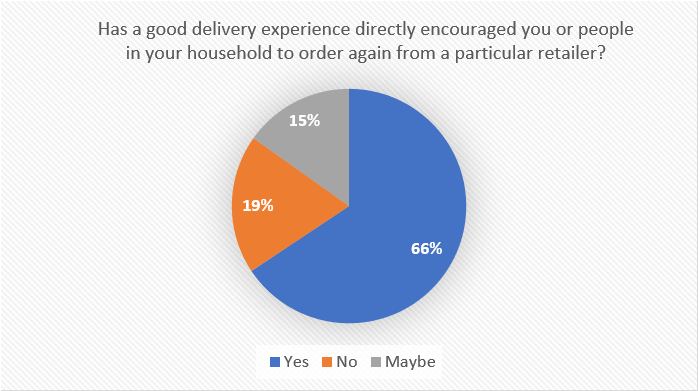
Last update: 03.07.2025
In this blog:
Intro- Offer a range of delivery options
- Package the parcel correctly
- Provide a range of pick-up and delivery locations
- Communicate with your customers ahead of delivery
- Offer an extended returns policy
Intro
Quality delivery is vital to keep customers coming back. When a parcel arrives damaged, or late, it can discourage those loyal customers from returning. In order to provide the smoothest delivery process possible, there are a few tips and tricks which retailers can use to ensure that they provide that perfect experience every time. Data from IMRG and nShift’s 2021 home delivery report shows that out of 1,000 respondents, 66% have been encouraged to make a repeat purchase, by a good delivery experience.

1. Offer a range of delivery options
Providing a range of delivery options to your customers is vital for ensuring they have the best chance of finding which one suits them. For example, more retailers are now offering options such as same-day delivery, or ‘eco’ delivery, allowing customers the option for quick, or carbon neutral, services. This way, the customer is in control from the beginning.
2. Package the parcel correctly
Parcel packaging may not sound important, so long as it makes it to the customer in one piece, however, it’s a seemingly small detail such as this which can make the difference. According to IMRG and nShift’s 2021 home delivery report, 40% of people have received an item with inappropriate packaging, and in 2021, 55% of people cited the reason for this being there was too little packaging, whilst 41% said there was too much—this can occur when shoppers end up digging through layers of cardboard and wrapping to get through to what turns out to be a small item, compared to the packing itself. To ensure that customers feel that their items are in safe hands, it’s important to provide expertly packaged goods, with just the right amount of protection from damage.
3. Provide a range of pick-up and delivery locations
Continuing from the preference for customers to be offered a variety of delivery options, they also want a variety of delivery locations. Many people have busy on-the-go lifestyles, or might not be home to collect their deliveries, but there are ways to get around this. It’s becoming increasingly popular to offer a pick-up point such as a locker or collection from a local post office, in order to help those customers who need flexibility. You can read our blog on pick up points and lockers to find out why they might also offer an eco-friendly solution to delivery needs.
4. Communicate with your customers ahead of delivery
Customers need to feel as though they’re in control, as from the moment they part with their money, until the delivery arrives, they are likely to be feeling particularly worried. They can be kept in the know through delivery updates, as our home delivery survey showed that the majority of customers would like to receive email or SMS text message. Our results showed that in 2021, almost 50% of respondents wanted to receive SMS updates about their delivery, whilst just over 40% wanted an email. Using tracking apps or going onto the retailer site is a far less popular method of communication. In order to keep your customers happy, you can use SMS and email to give them a 1-2hr time slot on the morning of the delivery.
5. Offer an extended returns policy
Finally, whilst returns aren’t part of the delivery process by itself, they are essential to the after-care of the customer. If a consumer decides they don’t like their item, retailers are required by law to offer a 14 day ‘cooling off period’, in which they can return it. However, 50% of customers believe that retailers should offer a 28 day returns policy, and only 30% say it should be 14 days. Interestingly, almost 10% even said it should be 45 days.
To summarize our key points, there are five ways you can ensure quality delivery for your customer: a range of delivery options, correct package, a range of delivery locations, communication, and offering extended returns policies. Through these methods, shoppers are likely to return to your store.
Deliver every order with speed, accuracy, and confidence
nShift powers every shipment with automation, carrier precision and full tech stack integration, all through the world’s most connected delivery platform.
Discover moreFurther reading: Delivery strategies FAQs
What are the key strategies to improve delivery quality?
To improve delivery quality, retailers should offer multiple delivery options, ensure items are well-packaged, and give customers flexibility in how they receive their orders. Good communication and simple return processes are also important for a smooth experience.
What delivery options should be offered?
Retailers should give customers a range of choices like standard, next-day, same-day, and eco-friendly delivery. This helps meet different needs and increases the chance of a completed purchase.
Why is packaging important?
Proper packaging helps protect products from damage during delivery and shows that the seller cares about the customer’s order. Using too much or too little packaging can lead to waste, higher costs, or unhappy customers.
Why provide different delivery or pickup locations?
Offering home delivery, lockers, and local pickup points gives customers more flexibility and convenience. It also helps reduce missed deliveries and can be better for the environment.
How should retailers communicate about delivery?
Retailers should keep customers updated with messages about the status of their delivery, like expected time and tracking links. This makes the experience feel more transparent and reliable.
Why offer extended returns policies?
Longer return windows give customers more confidence when buying, especially online. It reduces pressure and encourages them to shop again, knowing they can change their mind if needed.

Author
Gregory Mannix
Delivery Expert
With over 20 years of experience in SaaS, ecommerce, and logistics, Greg Mannix helps retailers and logistics providers streamline delivery operations. His expertise includes optimizing carrier management, enhancing tracking visibility, and simplifying returns to improve efficiency and customer satisfaction.

About the author
Gregory Mannix
Delivery Expert
With over 20 years of experience in SaaS, ecommerce, and logistics, Greg Mannix helps retailers and logistics providers streamline delivery operations. His expertise includes optimizing carrier management, enhancing tracking visibility, and simplifying returns to improve efficiency and customer satisfaction.





